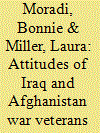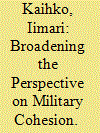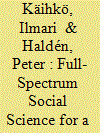|
|
|
Sort Order |
|
|
|
Items / Page
|
|
|
|
|
|
|
| Srl | Item |
| 1 |
ID:
094810


|
|
|
|
|
| Publication |
2010.
|
| Summary/Abstract |
U.S. policy banning openly gay and lesbian personnel from serving in its military rests on the belief that heterosexual discomfort with lesbian and gay service members in an integrated environment would degrade unit cohesion and readiness. To inform this policy, data from a 2006 survey of Iraq and Afghanistan war veterans are analyzed in this study. Views of these war veterans are consistent with prior surveys of military personnel showing declining support for the policy: from about 75 percent in 1993 to 40 percent in this survey. Among the demographic and military experience variables analyzed, comfort level with lesbian and gay people was the strongest correlate of attitudes toward the ban. War veterans indicated that the strongest argument against the ban is that sexual orientation is unrelated to job performance and that the strongest argument in favor of the ban is a projected negative impact on unit cohesion. However, analyses of these war veterans' ratings of unit cohesion and readiness revealed that knowing a gay or lesbian unit member is not uniquely associated with cohesion or readiness; instead, the quality of leaders, the quality of equipment, and the quality of training are the critical factors associated with unit cohesion and readiness.
|
|
|
|
|
|
|
|
|
|
|
|
|
|
|
|
| 2 |
ID:
161538


|
|
|
|
|
| Summary/Abstract |
It is difficult to underestimate the importance of cohesion for armed groups or organizations specialized and engaged in organized violence. This article argues that the recent debate on military cohesion has been far too narrow as it focused on Western state militaries during the 20th and 21st centuries, and even then only on the microlevel. It is necessary to broaden the perspective in order to construct theories that encompass even the vast majority of armed groups—the non-Western, nonstate, and nonmodern. This article advocates two ways of doing so: the investigation of cases that belong to these three types and broadening analysis to two new levels of analysis—the meso-level of armed groups and the macro-level, which contains state and society. Cohesion is established through harmonizing these three levels, which necessitates including them in the analysis in the first place.
|
|
|
|
|
|
|
|
|
|
|
|
|
|
|
|
| 3 |
ID:
173124


|
|
|
|
|
| Summary/Abstract |
In October 2018, Armed Forces & Society published a special issue dedicated to broadening the perspective on military cohesion from the narrow focus on 20th and 21st Western state militaries and the microlevel. The special issue emphasized the need for a theoretical and methodological broadening of the study of cohesion: In order to understand the majority of armed groups in the world, it is necessary to investigate macro- and mesolevel preconditions of microlevel cohesion. Such preconditions include the existence of states, nations, and modern military organization. These are specific to modern, Western contexts, and rarely feature in historical or non-Western cases. In many cases, investigating these preconditions requires qualitative methods. In a critical response, Siebold contested some of the arguments of the special issue, claiming that our argument was exaggerated and our methodologies inadequate. In this reply, we seek to clarify some of the issues and arguments at stake.
|
|
|
|
|
|
|
|
|
|
|
|
|
|
|
|
| 4 |
ID:
161537


|
|
|
|
|
| Summary/Abstract |
This Armed Forces & Society forum concentrates on broadening the perspective on military cohesion. This introduction, and the five articles that it acts as a preamble to, argues for the need to widen the scope of the recent debate on military cohesion, which in part took place in this very journal. This debate narrowly focused on Western state militaries during the 20th and 21st centuries and even then on the microlevel. The articles in this issue contribute to this broadening by exploring military cohesion in non-Western or nonmodern contexts, as well as through new methods, thus individually and collectively suggesting new ways forward to further our understanding of military cohesion.
|
|
|
|
|
|
|
|
|
|
|
|
|
|
|
|
| 5 |
ID:
106437


|
|
|
|
|
| Publication |
2011.
|
| Summary/Abstract |
The Standard Model has become the primary approach to military group cohesion. Yet the key theoretical drivers that explain where the Model came from have not been well articulated. This article addresses that deficiency by presenting those main drivers in past research and the key questions derived from the research that guided development of the Model. Additionally, recent research has brought several potential challenges to the Standard Model, which also have not been well articulated or presented together in one place. This effort addresses those theoretical problems as well as logically deduced challenges, which in all have been labeled by the author as the Horizon Problem, Individual Differences Problem, Roman Road Problem, Reductionist Problem, Life Cycle Problem, Frame Problem, Common Goal Problem, and Action Problem. Some limits to the Standard Model are noted in the process of showing how the Model can accommodate these challenges.
|
|
|
|
|
|
|
|
|
|
|
|
|
|
|
|
| 6 |
ID:
097073


|
|
|
| 7 |
ID:
158109


|
|
|
|
|
| Summary/Abstract |
Cohesion has a positive influence on many aspects of everyday life, including improved military performance. However, due to focus on the positives, many studies tend to omit potentially negative outcomes of cohesion. It is particularly important in regard to authoritarian military institutions, in which unit cohesion can have unintended consequence resulting in dehumanizing effect of the out-groups. The following research examines the process from cohesion to dehumanization and argues that there is a need to change the way how unit cohesion is achieved. The distinction is made between the controlled and autonomous cohesion. It will be argued that autonomous locus of causality is potentially more beneficial for military cohesion and performance in conflict environments.
|
|
|
|
|
|
|
|
|
|
|
|
|
|
|
|
| 8 |
ID:
184696


|
|
|
|
|
|
|
|